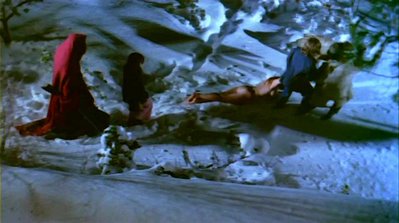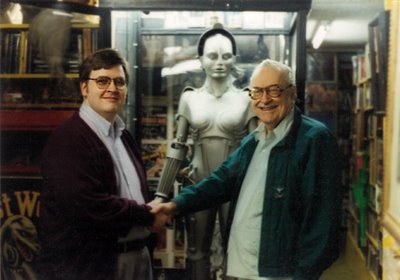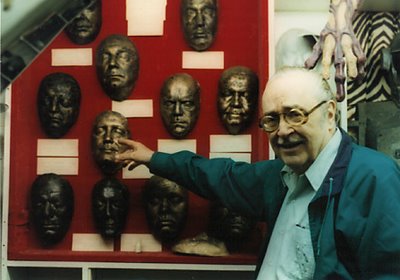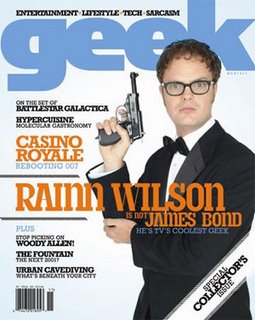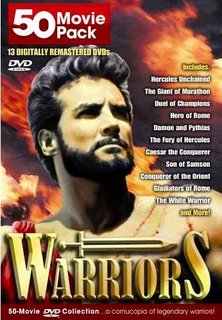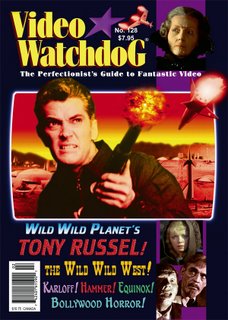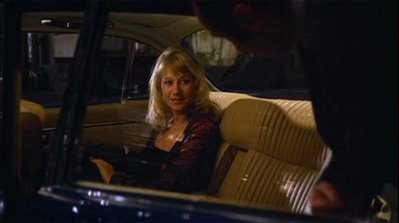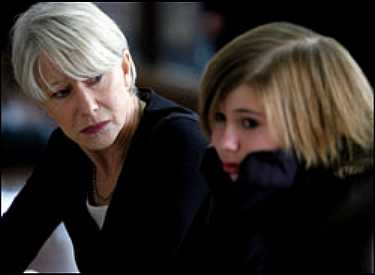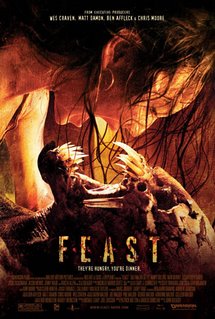
Today is Joe Dante’s 60th birthday, strange as that may seem. It’s hard to think of another filmmaker whose outlook has been, and remains, so perenially youthful; his protagonists are often children or child-like, and his projects have leaned toward stories of conflict between childlike idealism and the oppressive realities and counter-ideologies that would place barriers in the path of imagination in full flight.
Dante’s films are often caricatured as being heavily adorned with pop cultural references and in-jokes, but to simply note this element is not to understand it. The proliferation of fish and water jokes in PIRANHA (1978), for example, or the “Who’s Afraid of the Big Bad Wolf” clip in THE HOWLING (1980) are in place to acknowledge the difficulty of doing anything completely serious or original with such familiar material; it shows us how much cultural noise stands between us, as viewers, and fresh entertainment we should have every expectation of meeting head-on. And this brings us to the point where Dante’s work becomes so much more than merely pop-referential and -reverential. In a sense, his films use this material like a matador uses his red cape: he flaunts our familiarity with the territory, only to peel it away like a layer of skin and leaving us disoriented and newly vulnerable to attack.
Beginning with HOLLYWOOD BOULEVARD (1976) and continuing through the recent acclaimed MASTERS OF HORROR episode “Homecoming” (2005), the films of Joe Dante have always found ways to circumvent genre expectations, by daring to make us uncomfortable. The last reel of the comic HOLLYWOOD BOULEVARD suddenly posits us in the midst of a gory slasher film; even earlier than that, a rape scene in a sexploitation flick being shot in the Phillippines is shown crossing the line between cinema and reality, to the surprise of the movie’s star (Candice Rialson). Any director would play this joke just long enough to get the point across, but Dante holds the take until it scrapes our nerves and reminds the raincoat crowd of the violent crime that rape is. At the time of the film’s release, these points were either forgiven, on account of being in part of an exceedingly cheap maiden effort, or criticized for their tastelessness, but time has shown these aspects of Dante’s debut to be surprisingly consistent with the master plan (he said, tongue-in-cheek) of the work that followed.
Joe bumps into an old friend at Wonderfest in 2004.
In PIRANHA (1978), the genetically engineered “frankenfish” swimming upstream toward a children’s summer camp actually succeed in reaching the place, placing dozens of gaily splashing kids in the midst of serious danger, with camp director (something of a double entendre, that) Paul Bartel suddenly transformed from a fatuous figure of fun to a palpably tragic character. The heroine of THE HOWLING (1980) is not only voluntarily assassinated on national television at the end of the movie, but her death is quickly glossed over with a vignette culminating in the product shot of a hamburger pattie being fried up on a grill. Even a hit film like GREMLINS (1984) has to undercut the joyous warmth of its old-fashioned Christmas setting with Phoebe Cates telling the story of how her father met his untimely end by disguising himself as Santa and attempting to descend with holiday gifts through the chimney of his home, getting stuck and not getting discovered till the smell gave his caper away. EXPLORERS (1985), a movie that deliberately romances the possibility that a group of kids could build a working spacecraft with help from friendly aliens, works toward the epochal moment of communication with extraterrestial lifeforms only to expose them as beings braindead from being inundated with all the garbage broadcast into space on our airwaves. The creepy people who move into the derelict house in Tom Hanks’ suburban neighborhood in THE ‘BURBS (1989) are imagined to be cannibals or worse, and just when we give them the benefit of the doubt... they turn out to be malevolent after all! The element of surprise has always been one of Dante’s great strengths and he is especially adept at turning it against us, in the manner of a truly Swiftian satirist.
A number of the comic vignettes that Dante shot for the John Landis-produced omnibus AMAZON WOMEN ON THE MOON (1987) were omitted from the theatrical release “because John didn’t think they were funny” (as Joe once told me) – a mind-boggling prospect when one sees the stuff that made the cut, including a deliberately agonizing two-part skit (“Critics’ Corner” and “Roast Your Loved One”) featuring Archie Hahn. He stars as a regular guy who suffers a fatal heart attack while seeing his personal life scathingly reviewed on television by a pair of Siskel & Ebert stand-ins, and whose funeral is subsequently turned into a proverbial celebrity roast featuring the likes of Henny Youngman and Slappy White. Looking back, seeing this diptych in a theater was one of the more surprisingly expansive incidents in my movie-going life, perhaps as close as any movie-goer of my generation could get to experiencing the fresh taste of the “sick humor” (that is to say, confrontational humor) launched in the 1950s by Lenny Bruce, a comedian directly referenced in MATINEE. (Another “sick comic,” Brother Theodore, was prominently featured in THE ‘BURBS.)
Both of these skits made me extremely uncomfortable on the first pass, and I could also sense the discomfort of others in the auditorium with me, given the sudden epidemic of coughing, candy box-rattling, and noisy leg-crossings that broke out. There was a hushed sense of “Thank God that’s over” when the first part ended, and something just this side of an actual groan when we all realized we were only halfway done with this character. I can’t speak for anyone else who was with me that day, but I was intrigued. I was interested enough in my own reaction, and solid enough in my trust of Joe’s directorial instincts, to come back and see the film a second time; that second time, I could see this Mack Truck coming, knew what it was, and rolling with its punches instead of against them, I started laughing my ass off. I still do, when I see AMAZON WOMEN ON THE MOON today (though some of its deliberately funny material has lost some of its lustre over the years). In a sense, what Dante was doing here was Reichian comedy: pounding away at our emotional armor until our inner defense systems gave way, allowing us to experience at full strength the humor of our own worst fears – that the media might tap into our own worst secrets (the worst being our inconsequentiality in the great scheme of things), that we might be denied respect even in death, that our funerals might turn into a cheap burlesque where even our loved ones would laugh. “Reckless Youth,” the bizarre Dante-directed coda that ends AMAZON WOMEN -- a parody of the baleful Dwain Esper “teen pregnancy” exploitation reels of the 1930s -- has a similarly confrontational edge in that it shows us, beneath the impeccable surface layer joke of its camera and acting technique (both inept), how uncomfortable Americans continue to be when it comes to the matters of our own bodies and sexual education.
Dante’s “It’s A Good Life” remake for TWILIGHT ZONE: THE MOVIE (1983) initiated a thematic thread that would blossom into fuller expression in his two GREMLINS films (the second being the wonderfully no-holds-barred GREMLINS 2: THE NEW BATCH, 1990), namely the idea later revisited by the Spider-Man films: that with great power comes great responsibility. Dante gets to the heart of “It’s A Good Life” in a way the original TWILIGHT ZONE episode did not, showing that little Anthony (Jeremy Licht) is not inherently a monster but has become one because his family has allowed him to mature without the firm guiding hand that enters his life only with the accidental arrival of schoolteacher Helen Foley (Kathleen Quinlan). The Mogwai of the Gremlins films are analogous to Anthony’s reality-bending powers in that their potential for hazard is entrusted to the hands of young people who learn what can happen if you’re careless even once. Appropriately, when the Mogwai comes into contact with water, the resulting Gremlins are the very embodiment of antic, rampant Irresponsibility. And Joe Dante being Joe Dante, he couldn’t have experienced the irony of seeing his murderous, anarchic Gremlins merchandised as toys for children without responding with the underrated SMALL SOLDIERS (1998), in which we see the consequences of G.I. Joe-type action figures being beefed-up with military technology... which, of course, takes us back to the fine, finny, science-bred war machines of PIRANHA.
Dante, of course, was a child of the Vietnam War era and his collective works reflect an uneasy regard for the military, for politicians, and for big business, in all of which he sees a soullessness equal to that of the pods in Don Siegel’s INVASION OF THE BODY SNATCHERS (1955). Indeed, the shadows of war and partisan contretemps send a chill through the majority of his collected works, whether it’s overtly as in SMALL SOLDIERS, the military intentions behind the flesh-eating fish of PIRANHA, and the Cuban Missile Crisis backdrop of the magnificent MATINEE (1993, a classic killed at the boxoffice by a non-descript title), or more subtly, as in the microcosmic-cum-analogous war strategies THE ‘BURBS (with its suburban sergeant Bruce Dern), and the personal-cum-national politics of his impressive made-for-cable feature THE SECOND CIVIL WAR (1997, which assembles one of the finest casts of its decade).
But for much of Dante’s career, his own personal war has been with Hollywood – whose play-it-safe policies have been in increasing conflict with the kinds of movies he wants to make and stories he wants to tell. In the decade between 1993 and 2003, he directed only three theatrical features, working increasingly on cable and commercial television films and series (like EERIE, INDIANA), and devoting much of his time to projects that did not pan out (like the Charlie Haas script TERMITE TERRACE, a no-go that Joe has called the “heartbreaker” of his career), or did not pan out as planned (like the 1996 film of Lee Falk’s comicstrip THE PHANTOM, which he ended up executive producing rather than directing). Joe’s biggest opportunity of the past decade, LOONEY TUNES: BACK IN ACTION (2003), saw the either moribund or commercially sold-out cartoon characters of the Warner Bros. stable finally entrusted to the only director still living who understood them; unfortunately, with the film’s immense budget came even more immense second-guessing from the front office (“Why does he have to say, ‘What’s Up, Doc?’”). Though Bugs, Daffy and their celluloid cohorts live and breathe here as they haven’t done in decades, the end result is an amusing but overwritten conglomeration of the divine (the Louve sequence, for example), the magnificently apt, and the you’ve-got-to-be-kidding. BACK IN ACTION was Dante’s DANGER: DIABOLIK – a good movie, but a disappointing personal and artistic misadventure that seems to have redirected him back to the spirit of independent American cinema, where creative freedom can still thrive.
Joe bumps into an even older friend at Wonderfest 2004: Me.
For the last couple of years, when not filming standout episodes for MASTERS OF HORROR, Joe has been travelling the globe in search of funding for THE MAN WITH KALEIDOSCOPE EYES, a comedy script written by this writer and Charlie Largent about Roger Corman’s experiences prior to, during, and after his filming of his LSD epic THE TRIP (1967), and its role in the founding of the US independent film scene. In the time since Joe has optioned it, Charlie and I have done some rewrites, and there’s been an intermediary rewrite by Michael Almereyda and James Robison, and our script, as it now stands, reads like a bonafide Joe Dante movie, and one we’d all dearly love to see – a fascinating experience for me, as a writer and as a fan.
But it’s most of all as a friend that I want to wish Joe a happy birthday. We’ve known each other, though at a distance, for more than 25 years. I first got in touch with him back in 1980 to request an interview for a piece about contemporary horror trends I was preparing for HEAVY METAL magazine. I was nervous before calling him for the first time because I’d known his name since my boyhood, thanks to his bylines in CASTLE OF FRANKENSTEIN, and I was taken aback when he responded to my self-introduction with an undisguisedly familiar and impressed “Oh, HI!” (He knew me from my writings for CINEFANTASTIQUE.) I also spoke to David Cronenberg, George Romero, John Carpenter and Tom Savini for that article, but I felt the strongest personal affinity for Joe; by the end of that first call, we were finishing each other’s sentences. A decade later, he became one of VIDEO WATCHDOG's first subscribers, and a letter written in his own hand appeared in the Letterbox of our first issue. We first met face-to-face in 1993, around the time of MATINEE’s release. Later that year, he allowed me to co-host with him a 1993 Mario Bava retrospective at the American Cinematheque, where we talked, answered questions, and interviewed the likes of John Saxon and Harriet White Medin. (That night I also had the pleasure of speaking with Harriet’s escort, actor Robert Cornthwaite, whom I congratulated on his “virtuoso… or skilled" performance in Joe’s classic movie-within-a-movie, MANT.)
Some years ago, before he joined our pages with his “Fleapit Flashbacks” column, I told Joe that I had it in mind to devote an upcoming issue to his films. But, as fate would have it, when the time rolled around to begin that issue, I was well into my surprise obsession with Andy Milligan, which resulted not one... not two… but three feature articles. For some reason, Joe still talks to me, and I’m grateful. I still intend to do that Joe Dante issue, but I want to do it when I really feel it... and looking at the length of what I've written here, maybe that day was today! Anyway, until that mythic issue finally materializes, I hope this birthday blog will do – along with the other Blog-A-Thon offerings of the day.
Come to think of it, I have still more to say on this subject, so there just might be a Part 2, devoted to one of Joe’s lesser-known projects, later in the week.
In the meantime... Have a great day, Joe!
OTHER PARTICIPANTS IN THE JOE DANTE BLOG-A-THON:
Movie Morlocks.com: http://www.moviemorlocks.com/blog?action=detail&entry_id=8a25caad0f2cf4b9010f2d5f72c30002
Nadaland: http://nadalander.blogspot.com/2006/11/happy-birthday-joe-dante.html
The Exploding Kinetoscope: http://explodingkinetoscope.blogspot.com/
Joplin John: http://blog.myspace.com/joplinjohn
Film Ick: http://filmick.blogspot.com/2006/11/films-not-directed-by-joe-dante.html
KGB Films: http://kgbfilms.blogspot.com/
The Horror Blog: http://www.thehorrorblog.com/2006/11/28/half-dan-half-ante/
This Is Not A Dark Ride: http://e-ticket.livejournal.com/219658.html
Sergio Leone and the Infield Fly Rule: http://sergioleoneifr.blogspot.com/2006/11/joe-dantes-birthday-party.html




